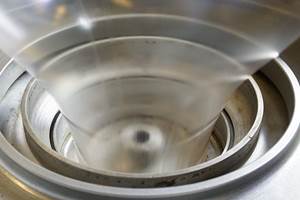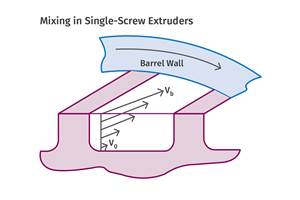The Power-Law Coefficient
Extrusion Know How
By referring to the power-law coefficient, the effect of barrel override in the metering section of many screws can be explained and anticipated.
The geometry of the screw makes shear heating hard to understand. Envision a flightless shaft turning in a tube. Visualize a very viscous fluid filling the space between the shaft and tube, and a slight bit of pressure at the right end. Since this imaginary material is very viscous it will take take a lot of work to turn the shaft. The slight pressure moves the viscous fluid from right to left.
The work by the shaft is converted to heat in the viscous fluid, known as viscous dissipation. The same thing happens with melted polymer in an actual extruder. The melt continues being heated by the rotation of the screw for as long as it remains in the barrel. The heat either stays in the polymer until it exits the extruder, or is removed from the system by passing through the barrel and cooling system.
It’s hard to cool polymers because they are poor conductors of heat. Polymers are, in fact, excellent insulators—their heat-transfer rate is less than 1% of that of steel.
Meanwhile, the rotation of the screw is adding heat continuously to the melt, offsetting what is extracted. Minor changes in barrel temperature have a very small effect on the overall withdrawal of heat from the system. As screw speed is increased, addition of heat from viscous dissipation usually overrides the ability of the cooling system to absorb heat, and the melt temperature continues to increase even with maximum cooling being applied.
Screw size is a factor as well. As screw size increases, the amount of polymer vs. the surface area of the barrel increases exponentially, so the effectiveness of barrel cooling is reduced.
Fortunately runaway temperatures are not the norm because polymer viscosity is decreased by both increasing temperature and shear rate (screw speed). As a result, most extrusion processes operate in a relatively narrow range of melt temperatures for a given polymer. That said, different polymers have different sensitivities to either shear rate or temperature.
Polymers can be described by the power-law coefficient, which is a simple relationship derived from the shear-rate/viscosity curves at different temperatures. It describes the viscosity in most of the processing range of the extruder.
Viscosity(µ) =m(T)Ÿn-1
Polymers have a consistency index (m) and a power-law coefficient (n) that describe its general viscosity behavior with respect to changing temperature (T) and shear rate (Ÿ). The consistency index is primarily the relationship between the polymer’s viscosity and temperature. Although useful in extrapolating the viscosity for design calculations, the consistency index is somewhat considered a dependent variable.
The power-law coefficient, however, has significant effect on heat generation, which in turn impacts the final temperature and resultant viscosity. This is important to understanding what can be expected for a polymer’s final melt temperature using a particular screw design. Polymers that have lower power-law coefficients will see a greater change in viscosity with changing shear. As the viscosity drops, the amount of energy required to rotate that portion of the screw will decrease and additional heat generated from the screw will be reduced. The accompanying table shows the consistency index and power-law coefficient for several polymer types, and the temperature range in which the values were established.
HDPE, for example, would be expected to reduce its viscosity by a factor of three compared with the viscosity reduction for nylon 66 over the same change in shear rate or screw speed. This means that the additional shear heating of HDPE would be less than for nylon 66 as screw speed increases.
By referring to the power-law coefficient, the effect of barrel override in the metering section of many screws can be explained and anticipated. Polymers with a high power-law coefficient would likely generate more heat in the melt with increasing shear rate through viscous dissipation. This adds another complexity to optimum extruder selection, wherein the ideal L/D can be influenced by the polymer’s power-law coefficient. In general, polymers with high power-law coefficients should be processed at lower screw speeds and on shorter L/D screws than those with low coefficients.
Related Content
Reduce Downtime and Scrap in the Blown Film Industry
The blown film sector now benefits from a tailored solution developed by Chem-Trend to preserve integrity of the bubble.
Read MoreSingle vs. Twin-Screw Extruders: Why Mixing is Different
There have been many attempts to provide twin-screw-like mixing in singles, but except at very limited outputs none have been adequate. The odds of future success are long due to the inherent differences in the equipment types.
Read MoreHow Polymer Melts in Single-Screw Extruders
Understanding how polymer melts in a single-screw extruder could help you optimize your screw design to eliminate defect-causing solid polymer fragments.
Read MoreShredding Thin Film: How to Do It Right
While many processors recoil at this task, a little know-how in shredding equipment, processing, and maintenance should add the necessary confidence.
Read MoreRead Next
People 4.0 – How to Get Buy-In from Your Staff for Industry 4.0 Systems
Implementing a production monitoring system as the foundation of a ‘smart factory’ is about integrating people with new technology as much as it is about integrating machines and computers. Here are tips from a company that has gone through the process.
Read MoreFor PLASTICS' CEO Seaholm, NPE to Shine Light on Sustainability Successes
With advocacy, communication and sustainability as three main pillars, Seaholm leads a trade association to NPE that ‘is more active today than we have ever been.’
Read More.jpg;width=70;height=70;mode=crop)












